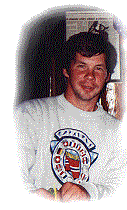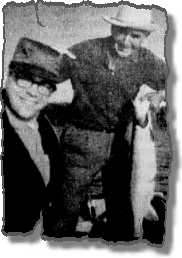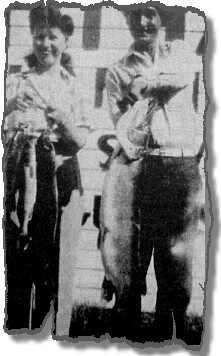 With one of the Chippewa Flowage's most
famous and favored musky haunts known to be Fleming's Bar, the name of Fleming
is bound to remain forever ingrained in the souls of the flowage faithful for
as long as these waters continue to flow. But what about the family for which
this spot was named...and their only son, who came to be known as one of the
flowage’s premier musky fishing guides during its heyday? While today's
angling generation may never have heard the name of John Fleming, he stood as
one in along line of native guides who seemed to possess a sixth sense about
the mysteries of the flowage...and of where muskies were hiding.
With one of the Chippewa Flowage's most
famous and favored musky haunts known to be Fleming's Bar, the name of Fleming
is bound to remain forever ingrained in the souls of the flowage faithful for
as long as these waters continue to flow. But what about the family for which
this spot was named...and their only son, who came to be known as one of the
flowage’s premier musky fishing guides during its heyday? While today's
angling generation may never have heard the name of John Fleming, he stood as
one in along line of native guides who seemed to possess a sixth sense about
the mysteries of the flowage...and of where muskies were hiding.
With the likes of Willie Belille, Fred Smith, and George James serving as some of Fleming's predecessors (guiding on its original lakes and rivers even before the flowage was formed) a steady stream of able Native guides were to follow in their wake during the coming years. Men like Edward DeMarr Sr., Charley Wolfe, Henry Smith, Ed Slater, Gorman Tainter, Edward "Swede" DeMarr Jr., Charlie "Man" Thayer, and young up-and-comers like Jack Hollen, Art Fleming, and "Mousey" Besoni were but some of the better-known Native guides of the flowage. But there was one name, that of John Fleming, which seemed to become synonymous with the term musky.
Born the only child to George and Julia Fleming, in Hayward on January 7' 1902, John Fleming came into this world during a time of bleak transition for Native American peoples. Instead of being raised in the old Ojibway traditions of his ancestors (a bygone era in which tightly knitted clans nomadically roamed the woodlands to hunt, fish, and gather while following the food…a free but often mortally harsh lifestyle during the long, hard Wisconsin winters) John was born during a time when the federal Government deprived young Indians of learning about their heritage and forced them to learn about the ways of the white man's world in some ways a more secure lifestyle, but one which was imposed on them at a high cost...cultural near-genocide.
John's father, George Fleming, was born in Odanah in 1863 and worked in the logging industry. Raising beef for the lumber camps during the logging days, George was said to have operated a cattle farm where Fleming's Bar today quietly rests beneath the waters of the flowage - hence the name of this most famous musky haunt. The Fleming homestead was located just off the north shores of Pokegama lake, about ¼ mile southwest of Desire lake (today known as Moonshine Lake) or ¾ of a mile due west of the heart of Old Post village.
With the old Chippewa trail coming up from Winter, located about 13 miles to the southeast, and going on to Hayward, which was about 20 miles to the northwest, the closer proximity of the village of Winter to the Post made commerce with Winter a bit more desirable. By the time John was born, the lumbering boom which had begun some 20 years earlier in this area was about over and activity at the Post was beginning to wane. Following the completion of the Hayward Indian boarding school in 1901, the Old Post school was closed by 1902 and from then until 1933, all Indian children were required to attend.
Young John Fleming must have been about 7 years old when he was taken from his family's home at the Post and sent to the boarding school. The government's idea of removing the Indian children from their own environment was two-fold: to guarantee more regular school attendance from the children but also to prohibit the children from learning the cultural traditions of their forefathers. Speaking their Ojibway language was strictly forbidden.
But instead of allowing the trauma of this time of family separation to embitter him, John drew positive motivation from this suppression and played the system to his benefit, learning as much as he possibly could about the ways of this new "white man's" world. After leaving school rich in knowledge, schooled in various trades, and an articulate man, John Fleming landed a good job managing an electrical company in St. Paul, Minnesota, for several years. Being able to save a fair amount of money, John then returned home to make his life here on what is now the Chippewa Flowage.
But things had changed since his boyhood days, for the village of Old Post was no more (it had been flooded over by the new flowage in 1923). The people of Old Post (and then later of New Post) had always been part of a very close-knit society, working together to live off the land hunting, fishing, and gathering and then returning to the village to share the bounty with all the rest of the village. In his younger years, John Fleming gathered wild rice and collected maple syrup (camping out in a wigwam during their harvest seasons) and, although one would have to travel far to find a good crop, also picked blueberries.
Known to be a hard and reliable worker, early on John worked for the family of Jess Ross at their sawmill near Moose lake and also worked for a logging company operated by Jack Morrison. On October 23, 1928, John married Marie DeMarr and the two operated a store for a few years, just to the west of the West Fork bridge, at new Riverside, a store which was called the Trading Post and later run by Ken and Anne Ackley. At that time, John operated his own sawmill just across the road from his store and employed a number of his relatives to work for him. A kind-hearted John allowed many of them credit and, once they couldn't pay him back, John ended up losing the business.
Always possessing a natural love for fishing and the outdoors, John had begun guiding fishermen by this time, vocation which he carried on for the next 42 years and one which had brought him much notoriety. Along the way, John and Marie eventually had 11 children: Delphine, Jerome (who died as an infant), Theresa, Art, Mary Rose, Julie Ann, John E., Eugene, Virgil (James), Agnes, and Floyd. John also had another son, Frank, from a previous relationship before he married. But in addition to his blood family, John began building a loyal guide clientele of repeat customers…some of whom became part of John's extended "family."
 Although he did some guiding on Grindstone
and Lac Courte Oreilles, Fleming's primary fishing grounds were the sprawling
waters of the Chippewa Flowage, with the Blueberry Creek area, Sand Island,
Pete's Bar, and, of course, Fleming's Bar being but a few of his regular
haunts. Old John knew this entire confusing maze of islands, bays, shallow
bars, and moving bogs, known as the flowage, well enough that it had become
second nature for him to navigate its wilds, even after dark. It was said that
a doctor once hired John to guide him to every nook and cranny on the flowage
which was likely to hold a musky and it took the men two or three months just
to begin to cover it.
Although he did some guiding on Grindstone
and Lac Courte Oreilles, Fleming's primary fishing grounds were the sprawling
waters of the Chippewa Flowage, with the Blueberry Creek area, Sand Island,
Pete's Bar, and, of course, Fleming's Bar being but a few of his regular
haunts. Old John knew this entire confusing maze of islands, bays, shallow
bars, and moving bogs, known as the flowage, well enough that it had become
second nature for him to navigate its wilds, even after dark. It was said that
a doctor once hired John to guide him to every nook and cranny on the flowage
which was likely to hold a musky and it took the men two or three months just
to begin to cover it.
 Guiding out of Billy DeBrot's Indian Post
Resort and Chris Lee's (later Kelly's and then Herman's Landing), Fleming
built up a roster of steady clients over the years, of whom two of his
favorites were Bill and Katherine Moretti. The Moretti's used to stay on Moose
lake, until they heard a number of glowing reports on the Chippewa Flowage's
top guide-John Fleming. John's daughter Delphine was only 12 years old and
waiting tables at Kelly's Landing when, during the summer of 1941, she
remembered her father guiding the Morettis one day and they weren't out very
long when they came back in with a huge musky. Nearly a world’s record,
John's fish was the biggest musky ever taken out of the flowage at the time.
This 56" class fish was said to have weighed 52#, according to Bruce
Tasker. (Tasker, who would begin his own guide career a few years later, was
given Fleming's guide boat to use at Herman's, old boat no.23, whenever John
wasn't using it.)
Guiding out of Billy DeBrot's Indian Post
Resort and Chris Lee's (later Kelly's and then Herman's Landing), Fleming
built up a roster of steady clients over the years, of whom two of his
favorites were Bill and Katherine Moretti. The Moretti's used to stay on Moose
lake, until they heard a number of glowing reports on the Chippewa Flowage's
top guide-John Fleming. John's daughter Delphine was only 12 years old and
waiting tables at Kelly's Landing when, during the summer of 1941, she
remembered her father guiding the Morettis one day and they weren't out very
long when they came back in with a huge musky. Nearly a world’s record,
John's fish was the biggest musky ever taken out of the flowage at the time.
This 56" class fish was said to have weighed 52#, according to Bruce
Tasker. (Tasker, who would begin his own guide career a few years later, was
given Fleming's guide boat to use at Herman's, old boat no.23, whenever John
wasn't using it.)
When John first started guiding out of Lee's, fishermen were still rowing their boats to get out to their fishing grounds. Silk fishing line and direct drive reels were being used back then. John once guided his friend, Gerald Thalacker Sr., to two big muskies in one day, which that early equipment ended up bloodying his knuckles up pretty good. Like all the guides of his day, John prepared shore lunches for his clients, today largely a forgotten pleasure in this more fast-paced world. Fleming was a quiet kind of a guy in the boat, but if you got startled as a musky would make a make sneak attack on your surface bait be would laugh. Always enjoying the strike of a surface lure, John kept two of his favorite old standbys---a Globe and a Surf-Oreno at the ready, hidden inconspicuously in an old cigar box. A kind, jolly, and articulate man, Fleming was indeed a popularly requested guide in his day.
It was probably during the mid to late 1930s when John and Marie and their family moved from Riverside to New Post, to a little log cabin located next to his father's (George’s) place. John still worked m a logger and was frequently in demand to operate heavy equipment. He plowed roads for the County and also supervised the building of a number of roads on the Reservation. On one occasion, Father Polinus couldn't make Sunday service at church, so much to the surprise and amazement of his children, John steeped and spoke in the father's place. John was known to have a good tenor voice and also played the violin.
After John and his family left New Post and moved to a nice home near Blueberry lake, his son, Frank, remained to .watch over George. Having a convenient boat access near his Blueberry home Fleming remained a regular presence on the Flowage for some time. One nasty and rainy day, while John happened to be at Herman’s Landing, some wise guy at the bar who knew of Fleming's fishing prowess, chided, "I bet even you couldn't catch one today, John". So, on a bet, John proceeded to go out fishing…and got a musky within an hour!
 An unusual Musky tale was played out on
Labor Day in 1954, when Robert Risberg caught a 26½ pounder on a Bobbie Bait
on Pete's Bar. While fishing alone, just as young Risberg jerked his lure one
final time and he watched it pop up near the boat, he witnessed the head of a
big musky come up from the depths…jaws wide open and gills flared…clamp
right down on his lure! What a heart stopper! Risberg thought that, at any
moment, this musky would go berserk and tear everything up, but it just laid
there motionless.
An unusual Musky tale was played out on
Labor Day in 1954, when Robert Risberg caught a 26½ pounder on a Bobbie Bait
on Pete's Bar. While fishing alone, just as young Risberg jerked his lure one
final time and he watched it pop up near the boat, he witnessed the head of a
big musky come up from the depths…jaws wide open and gills flared…clamp
right down on his lure! What a heart stopper! Risberg thought that, at any
moment, this musky would go berserk and tear everything up, but it just laid
there motionless.
The pistol was close at hand so, while he had the chance, Robert grabbed the gun and shot, causing the big musky to make a violent death spiral straight down towards the bottom. Risberg was trying to pressure the musky back to the surface but he couldn't budge it, almost as if it was stuck on a stump or something. And then assistance came in the form of John Fleming. Noticing his predicament, Fleming, who had been guiding nearby, came over and got into Risberg's boat, rowed over to the fish' and freed it with the oar. As it turned out, the musky had lunged away from the boat so fast, and with so much velocity towards the bottom, that the musky had burrowed its head deep into the soft, sandy bottom.
For a number of years John had a lawyer for a guide client who enjoyed fishing with him so much that, upon arranging a fishing trip to Canada's Hudson Bay for himself, he flew John up to join him. It was said that a national outdoors magazine, like Outdoor Life or Field & Stream, once did a story about John during the '40s or ‘50s. It was probably around 1960 that John pretty much retired from guiding until a young teen named Art Gross rekindled Fleming's interest in getting back on the water. Not really wanting to take him out at first, once John learned that Art was Katherine Moretti's grandson (one of his favorite clients from years back), John agreed to come out of retirement just for Art.
John and Art continued their annual fishing trips right up until nearly the time that John passed away on June 24, 1976. John's father, George, had preceded him in death almost exactly 21 years earlier, after a long illness, at the age of 92. John's son, Art, has taken up where his father had left off, guiding for a number of years now and being well acquainted with both the flowage and its number one inhabitant, the musky...just as John C. Fleming was.